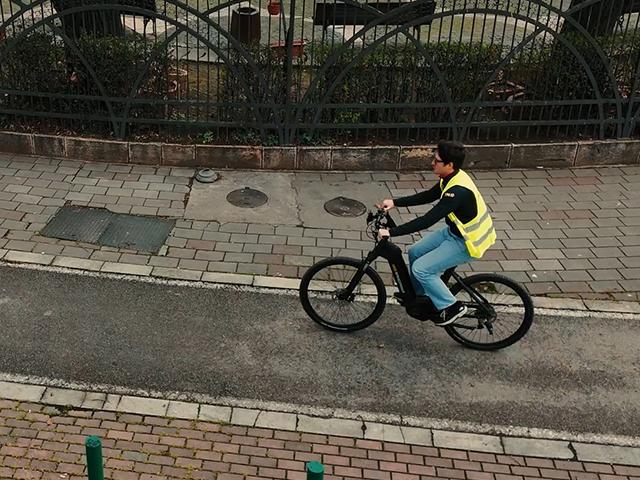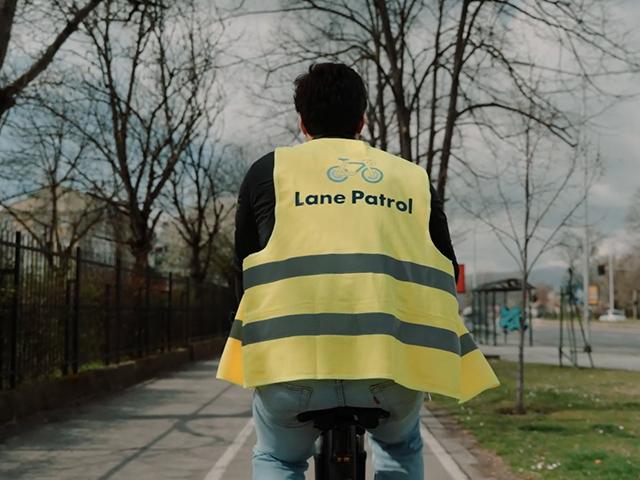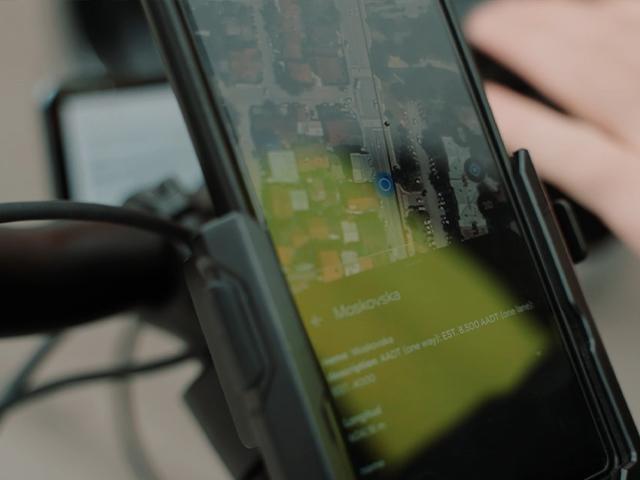Initiative details
In the vision of becoming a cycling-friendly city, the City of Skopje invests massively in new and renovated cycling paths. Only last year, 40 kilometers of cycling paths in the city were opened, but due to a lack of expertise, they are with many flaws. As a result, the main focus of the project proposal is to increase the safety of bike commuters by providing independent assessments of the safety and quality of cycling infrastructure using the CycleRAP methodology. This is important for mobility planners and decision makers to understand the cycling infrastructure safety and develop investment plans that are evidence-based. In cooperation with the Factual, accredited partner and Advisory Board member of CycleRAP, we will not only provide safety assessment of the cycling infrastructure based on the CycleRAP methodology, but we will also provide evidence – based recommendations for increasing the safety of the cycling paths, while providing capacity building at the same time.
Initiative date
to
Who was/is your target audience?
Policy makers
Public authorities
Topic
Create awareness
Improve vehicles and infrastructure
Knowledge building and sharing
Organisation details
Auto Moto Association of Macedonia - AMSM
Association
The former Yugoslav Republic of Macedonia
Skopje, North Macedonia
Contact name
Blagica Stanojevic Blazevski
Telephone number
+38972214866
bstanojevikj@amsm.com.mk
Website link
Project activities
If you work together with external partners, list the most important partners and briefly describe their role.
Factual - one of the three accredited suppliers from iRAP is project partner responsible for the to implementation of the CycleRAP methodology
NaTochak – non-formal cycling community is project partner responsible for marking and mapping all 130km of cycling lanes on the territory of City of Skopje that are included in the process of assessment, promoting the project and supporting lobbying activities.
Republic Council for Road Traffic Safety – as the highest government body in charge of the road safety is project partner responsible to support lobbying activities and furthermore to invest in implementation of recommendations of several cycling lanes by their choice
NaTochak – non-formal cycling community is project partner responsible for marking and mapping all 130km of cycling lanes on the territory of City of Skopje that are included in the process of assessment, promoting the project and supporting lobbying activities.
Republic Council for Road Traffic Safety – as the highest government body in charge of the road safety is project partner responsible to support lobbying activities and furthermore to invest in implementation of recommendations of several cycling lanes by their choice
Please describe the project activities you carried/are carrying out and the time period over which these were implemented.
Establishing partnerships with Factual, one of the three accredited suppliers from iRAP to implement the CycleRAP methodology as project partner, as well as other stakeholders: non-formal cycling community NaTochak, Republic Council for Road Traffic Safety – RSBSP (September-November 2023)
- Mapping 130km of cycling routes on the territory of City of Skopje in cooperation with the non-formal cycling community NaTochak (January-February)
- Conducting cycle lane survey, using our partner’s solution which can collect the geolocation and >140º images (March)
- Attribute coding by analyzing the images collected (March-April)
- Give star ratings (April-May)
- Capacity building and training of AMSM staff to deploy a continuous cycle lane network assessment to improve road safety (June)
- Generating a report with recommendations and investment plans for improving the safety performance of the cycling infrastructure, including improvement of the star ratings assessment (June-July)
- Lobbing for implementation of the recommendations and investment plans by City of Skopje and the units of the local self-government (September – November)
- Project communication (March – November)
- Mapping 130km of cycling routes on the territory of City of Skopje in cooperation with the non-formal cycling community NaTochak (January-February)
- Conducting cycle lane survey, using our partner’s solution which can collect the geolocation and >140º images (March)
- Attribute coding by analyzing the images collected (March-April)
- Give star ratings (April-May)
- Capacity building and training of AMSM staff to deploy a continuous cycle lane network assessment to improve road safety (June)
- Generating a report with recommendations and investment plans for improving the safety performance of the cycling infrastructure, including improvement of the star ratings assessment (June-July)
- Lobbing for implementation of the recommendations and investment plans by City of Skopje and the units of the local self-government (September – November)
- Project communication (March – November)
In terms of implementation, what worked well and what challenges did you need to overcome?
There have been no challenges in the implementation process of the project so far, because the project is financially supported by the FIA Foundation for Greater Road Safety and all activities so far have been organized by AMSM as the project leader. The biggest challenge will be the process of lobbying for the implementation of the recommendations and the necessary investments by the city of Skopje and the municipalities in order to improve the star ranking and the overall safety of the bicycle paths and lanes.
We expect that we will overcome this challenge with continuous lobbying and pressure from both the formal and informal cycling communities for the implementation of the recommendations by the authorities.
We expect that we will overcome this challenge with continuous lobbying and pressure from both the formal and informal cycling communities for the implementation of the recommendations by the authorities.
Evaluation
Please summarise how you have evaluated the initiative’s impact (e.g. social media reach, survey, feedback forms, statistics).
Тhe success of the initiative will be measured as following:
- Increased awareness for cyclists’ road safety;
- Increased club’s capacities to understand the state of cycling infrastructure safety and develop cycling infrastructure investment plans that are evidence-based and follow international safety benchmarks and standards;
- Interest for the cycling safety content published on the special project landing page based on the Google Analytics;
- Increased reach and engagement on social media;
- Increased image of the AMSM as mobility club determined through a survey before and after the project implementation
- Increased safety of the bike commuters determined through a survey of their opinion regarding of the safety of cycling infrastructure before the assessment and after implementation of the proposed safety measures; etc.
The ultimate goal to measure the initiative’s impact is at least 50% of the safety measures proposed to be implemented by the authorities no later than 2026
- Increased awareness for cyclists’ road safety;
- Increased club’s capacities to understand the state of cycling infrastructure safety and develop cycling infrastructure investment plans that are evidence-based and follow international safety benchmarks and standards;
- Interest for the cycling safety content published on the special project landing page based on the Google Analytics;
- Increased reach and engagement on social media;
- Increased image of the AMSM as mobility club determined through a survey before and after the project implementation
- Increased safety of the bike commuters determined through a survey of their opinion regarding of the safety of cycling infrastructure before the assessment and after implementation of the proposed safety measures; etc.
The ultimate goal to measure the initiative’s impact is at least 50% of the safety measures proposed to be implemented by the authorities no later than 2026
What has been the effect of the activities?
Up to this stage of implementation, the project has caused only positive reactions among city cyclists, as evidenced by the inclusion of the informal cycling community NaTochak as a partner in the project. The increased number of visits to the project's landing page and the increased reach and number of followers on social media for 20% speak for the effect of the project so far. The project also provoked interest of the media, expressed through invitations for guest appearances and PR texts. The greatest effects of the project are expected after the publication of the CycleRAP Assessment Report, which will contain a one to five star ranking of each path depending on cyclists' safety, as well as recommendations for improvements by taking specific measures and investments. The ultimate goal to measure the initiative’s impact is at least 50% of the safety measures proposed to be implemented by the authorities no later than 2026, which will directly contribute to the reduction of road crashes, injuries and deaths. The project was not only recognized locally, but also regionally, as we are the first country to implement CycleRAP methodology in the region, and internationally since we are the first in Europe to assess length of 130km cycling infrastructure.
Please briefly explain why your initiative is a good example of improving road safety.
The proposed intervention will certainly improve road safety for cyclists as the initiative is based on the CycleRAP methodology for defining the safety level of cycling infrastructure without the need for accident data. The project refers to the evaluation of different characteristics of bicycle paths using the CycleRAP methodology, an international and evidence-based model that should become an international benchmark for the maintenance and design of safe bicycle infrastructure. The final report from the implementation of the CycleRAP methodology will contain specific measures and investments needed to improve the safety of the cycling infrastructure. This report should be a guide for institutions to act in order to improve the safety of cyclists. The project is certainly a good practice for others to learn from, and it is easy to be implemented.
How have you shared information about your project and its results?
The project communication is based on a mix of different communication tools, such as:
- Social media
- Video marketing
- Website
- Blogs
- Direct meetings with mobility planners, policymakers, and decision-makers
- Email marketing
- Public relations
- Print collaterals etc.
- Social media
- Video marketing
- Website
- Blogs
- Direct meetings with mobility planners, policymakers, and decision-makers
- Email marketing
- Public relations
- Print collaterals etc.
Supporting materials









